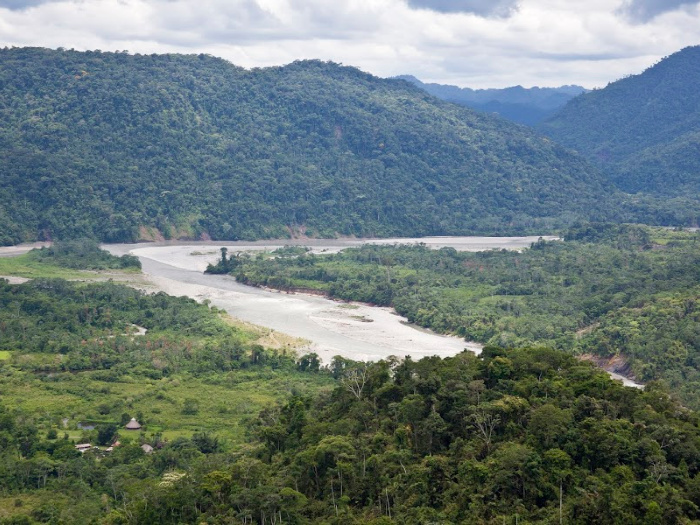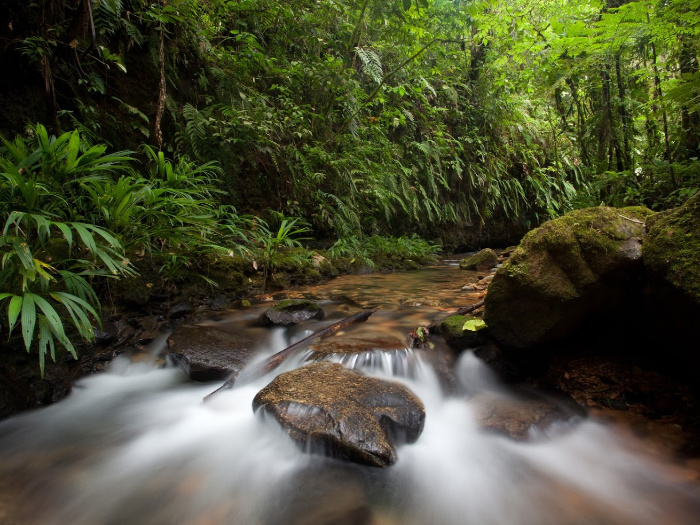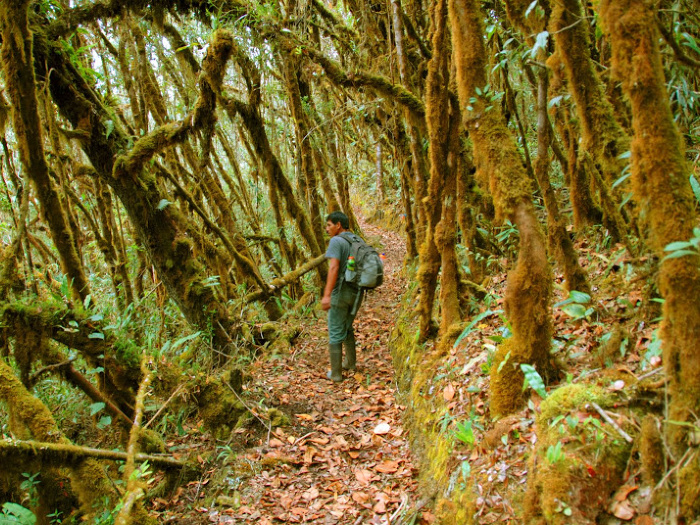Keeping forests standing is crucial for a healthy planet and affects our daily lives without us knowing it.
We have created replicable conservation models for conservation, most notably the concept of conservation concessions, where a national government relies on a private partner such as us to manage public land for conservation.
In 2000, we created the 360,000-acre Los Amigos Conservation Concession, the first of its kind in the world, and have been successfully managing it since then.
This model of conservation has been successfully applied elsewhere in the region and around the world, helping remove the financial and operational burden of land management from strained governments.

We protect landscapes with an eye toward the big picture of connecting tracts of protected areas over time, magnifying our impact for biodiversity conservation.
Our impact goes beyond the boundaries of the conservation areas we help create. We work in the vast land between conservation areas to ensure connectivity among them.
By doing so, we ensure animals can move across uninterrupted patches of tropical forests, which is vital for species preservation and a healthy forest.

Directly protecting forests is at the core of all the conservation efforts we do.
We focus on identifying, creating and caring for parks, reserves, and other types of conservation areas.
We work with governments, individual landowners, indigenous communities, and others to build a network of protected lands in Peru and Bolivia, creating a living conservation mosaic.

Amazon Conservation has reforested degraded lands with over 250,000 trees to date, most through community-based reforestation projects in the Manu National Park buffer zone.
We prioritize reforestation with native species, which help restore ecosystems and ensure continued provision of ecosystem services, such as carbon sequestration, water regulation, and soil conservation.
Our reforestation model is linked with a holistic approach to strengthening community land management, including territorial planning and reclaiming ancestral agricultural practices. This both improves long-term durability of conservation outcomes and increases household incomes.

We defend the forests which cannot defend themselves.
By using cutting-edge technology like satellite imagery, radar, drones, and camera traps through our MAAP Project and our Southwest Amazon Drone Center, we are able to find, track, and expose deforestation happening on the ground in near-real time.
This enables us to alert the public and local authorities to mobilize and stop deforestation before it gets to a point of no return.
Our research stations in Peru and Bolivia offer premier facilities in strategic locations of the Andean Amazon’s altitudinal gradient that allow scientists to conduct short-term and long-term studies on the ground.
These studies contribute to the global scientific community, raise awareness about tropical ecology and conservation, and inform our conservation decisions.
Conservation concessions and conservation corridors are critical to protecting forest cover and biodiversity across the southwestern Amazon.
It’s a public/private partnership designed to promote conservation, biodiversity, and sustainable development.
This groundbreaking concept– a “conservation concession” – facilitates the participation of private organizations in achieving national biodiversity conservation goals by entrusting the long-term protection of publicly-owned land to not-for-profit institutions in exchange for investments in conservation and sustainable development.
Today, our Los Amigos conservation concession is among the Amazon’s most active centers for research, natural resource management training, and environmental education. The conservation concession model has now been replicated in other places throughout Peru, and even as far away as China, covering close to 5 million acres.
Conservation corridors provide freedom of movement for animals and allow for biodiversity and the ecological and evolutionary processes.
A conservation corridor is a native wildlife habitat that is undisturbed by human activity that joins larger areas of similar wildlife habitat. These corridors are critical to maintaining the natural ecological process, allowing the movement of animals throughout their natural space.
Manu – Tambopata Corridor: from Manu National Park to Tambopata National Reserve. The Manu – Tambopata (MAT) Corridor connects Peru’s Manu National Park with Bolivia’s Madidi National Park via ACA’s Los Amigos Conservation Concession and the Tambopata National Reserve.
The last unprotected stretch, a north-south corridor that crosses the Interoceanic Highway to the Malinowsky River, will protect over 518,920 acres (210,000 hectares) of tropical forest. ACA’s Los Amigos Biological Station (CICRA), one of the most productive research stations in the Amazon basin, is located here.
Castaña Corridor: from Las Piedras River in Peru to Manuripi National Reserve in Bolivia. The Castaña Corridor incorporates much of ACA’s earlier conservation efforts to develop the first Brazil nut concessions in Peru. We currently provide technical support and training to more than 420 families in northern Madre de Dios and several in the buffer zone of Tambopata National Reserve. These concessions cover 875,998 acres (354,504 hectares) of primary forest along the Interoceanic Highway.
The Castaña Corridor also protects the habitat of keystone species like jaguars in the Las Piedras River basin.
Yungas Corridor: from Manu National Park to Bahuaja Sonene National Park. The Yungas Corridor is designed to protect an unbroken stretch of forest from lowland valleys to Andean highlands between Manu and Bahuaja Sonene National Parks.
Climate change is expected to force species to migrate to higher elevations, and this corridor will provide a refuge for a genetically diverse population of plants and animals.
Amazon Conservation pioneers innovative conservation tools, creating models that others can follow, and, in 2001, Amazon Conservation and Conservación Amazónica-ACCA established the world’s first private conservation concession.
In Peru, as in other countries in Latin America, a substantial portion of the land is publicly owned. Although national conservation policies may contemplate the protection of these areas, governments frequently lack the human and financial resources to implement effective on-the-ground actions.
Amazon Conservation negotiated with the Peruvian government to develop a new way to help protect forests under state control. In Peru, the contracts are perpetually renewable, given for 40 years initially and subject to an evaluation of compliance every 5 years.
Today, the Los Amigos Conservation Concession protects the watershed of the Los Amigos River and 360,000 acres of old-growth Amazonian forest in the department of Madre de Dios in southeastern Peru.
Los Amigos is home to a remarkable diversity of plant and animal species. Bordering world-famous Manu National Park to the east, the Los Amigos watershed forms part of a 20 million-acre block of protected wilderness in southeastern Peru.
The landscape is a mosaic of terrestrial and aquatic habitats, including palm swamps, bamboo thickets, oxbow lakes, and various types of flooded and non-flooded forests. Wildlife is abundant, including 12 globally threatened species and abundant Amazonian fauna including giant otters, harpy eagles, spider monkeys, and jaguars. The area contains 13 species of primates. By way of comparison, all of Costa Rica holds only four.
Our ongoing management of the Los Amigos Conservation Concession will:
Haramba Queros is an indigenous community of the Wachiperi ethnicity living in the lush rainforests in the foothills of the Andes mountains, located 4 hours east of Cusco, Peru. They depend on their forest homeland for food, shelter, traditional clothing, and natural medicines.
In July 2008, the Haramba Queros Wachiperi Ecological Reserve became the world’s first conservation concession managed by an indigenous group. The Haramba Queros Wachiperi Conservation Concession protects 17,238 acres of highly diverse montane rainforest on the eastern slopes of Peru’s southern Andes.
It provides a buffer against the impacts of climate change, secures the Queros’ water supply and source of medicinal plants, sustains their access to forest products, and helps the community maintain its cultural traditions. These forests also serve as an ecological buffer zone for the world-renowned Manu National Park.
Amazon Conservation and its Peruvian sister organization, Conservación Amazónica-ACCA, provided technical support to the Wachiperi throughout the process of applying for the concession, creating its management plan, and seeking approval from the Peruvian forest service.
We continue to support the Queros community in their management and monitoring of the concession, as well as in the development of sustainable livelihoods activities, such as ecotourism and handicraft production, which help fund the management of the concession.
Conservation concessions, an innovation written into Peruvian forestry legislation in 2000, provide a unique opportunity for the conservation of large state-owned lands that would otherwise be unmanaged. A conservation concession is a long-term contractual partnership between the national government and a non-government actor, whereby the civil society actor manages state-owned lands for purposes of ecosystem and biodiversity conservation.
In Peru, SERFORdr is the national agency overseeing conservation concessions.
SERFOR is required by law to approve a technical proposal drafted by the applicant organization prior to awarding a conservation concession. Once the technical proposal is approved, the applicant prepares a management plan that includes an investment commitment. The award process involves substantial public consultations with local and regional stakeholders, including local communities, regional authorities, and the private sector.
Once the concession is awarded, the concessionaire provides annual reports and inspections as well as comprehensive evaluation by SERFOR every five years to verify compliance with the management plan, if the concessionaire is found to comply with the management plan the contract is automatically extended for another forty-year period.
For 25 years, Amazon Conservation has worked hand in hand with Indigenous communities, scientists, and local partners to protect the Amazon’s most important forests and rivers. From the remote biological stations in the heart of the rainforest to remote, biodiversity-rich protected areas, our teams are on the ground monitoring wildlife, restoring habitats, and supporting sustainable […]
The Amazon is one of the most extraordinary places on Earth. Its forests breathe life into the world, its rivers flow like veins carrying water and energy, and its people and wildlife embody a resilience that inspires us all. But the Amazon is at a crossroads. Rising pressures from deforestation, fires, and climate change are […]
As part of a significant step in advancing the sustainable management of regional conservation areas in Peru, our sister organization in Peru Conservación Amazónica–ACCA donated 290,000 Peruvian Soles (about $77,100) to the Cuzco Regional Government in support of a project aiming to create a regional system of protected areas in the country’s Andes-Amazon region. This […]